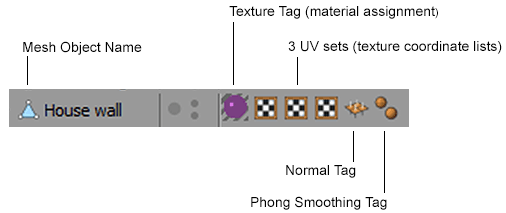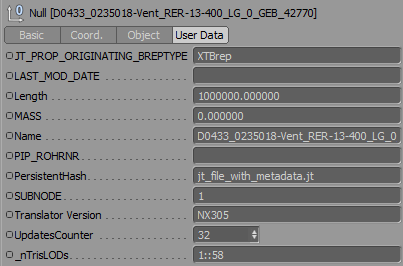| You are here: Home » Import CAD Formats » NGRAIN's 3KO Solutions |


Output Mesh Geometry
This checkbox should not, in general, need to be disabled. It controls whether polygonal mesh data will be output to the CINEMA-4D file. This is the main and primary geometry type used by the CINEMA-4D software.
Note: CINEMA-4D does not support vertex colors and does not support 3D point cloud data output.
The following screen snapshot from CINEMA-4D shows how the material (Texture Tags), UVW sets and Normal Tag are associated with a mesh object:

Output vertex normals
If this checkbox is checkmarked then vertex normals will be exported along with the mesh geometry. Vertex normals are required to provide the "smoothing" information for a mesh model. The set of vertex normals will show up as a "Normal Tag" within the CINEMA-4D hierarchy window, assigned to the associated polygonal object.
Disabling this option may make for smaller .c4d files but at the expense of making the models appear faceted.
Note: Most of the free converters which come built-in to the MAXON CINEMA-4D software do not, or cannot, import such vertex normals and hence lead to shading anomalies and black banding on imported model data, especially CAD data. Hence, do not use them.
Output skinning weights
"Mesh skinning" is the process of deforming a single skin mesh with a skeleton of bones or any hierarchical set of transform nodes. The contribution of each bone of the skeleton to the deformation of a vertex in the mesh is controlled by vertex weights.
If this option is enabled then a single polygonal mesh will be bound to one or more secondary objects ( "deformers", such as bones) via transformation matrices and weight values in the CINEMA-4D file.
The set of vertex skinning weights will show up as a "Weight Tag" within the CINEMA-4D hierarchy window, assigned to the associated polygonal object. The polygonal mesh object will also have a new child object of type "Skin" assigned to it.
Only skinned meshes are supported for export, not skinned NURBS surfaces or skinned curves.
Typical sources of skinned mesh data are 3ds Max, Maya, LightWave, Softimage (XSI), FBX, Collada, DirectX and U3D.
Output vertex UV texture map coordinates
If this checkbox is checkmarked then (u,v) vertex texture coordinates will be exported along with the mesh geometry. These are needed to define the mapping of 2D texture images onto the 3D mesh geometry. Disabling this option may result in smaller CINEMA-4D files, but at the expense of not being able to map 2D texture images onto the mesh geometry.
The (u,v) vertex texture coordinates will show up as a "Texture Tag" within the CINEMA-4D hierarchy window, assigned to the associated polygonal object.
Include unreferenced UV sets
Okino software, and many source programs such as 3ds Max, Maya, LightWave, FBX, Collada and Softimage, allow for "multiple sets of (u,v) vertex texture coordinates" per polygonal object. For example, you may have a single mesh object which represents a hull of an airplane but two sets of (u,v) coordinates - one set is used to place the texture map for the hull's entire surface while the second set of (u,v) coordinates are used to place localized decals over the hull's surface.
Enabling this option will force every (u,v)-set to be output to the CINEMA-4D file which was associated with the original source mesh, regardless of whether a uv-set has been used along with a material shader or not. The multiple sets of (u,v) vertex texture coordinates will show up as multiple "Texture Tags" within the CINEMA-4D hierarchy window
NOTE: Enabling this option might result in duplicated uv-sets being written out. You can re-arrange and/or delete specific uv-sets as need be within the user interface of CINEMA-4D.
Output NURBS Surfaces (as polygonalized mesh geometry)
If this checkbox is checkmarkedthen any trimmed NURBS objects will be tessellated into a polygon mesh prior to export. If it remains uncheckmarked then any trimmed NURBS data will not be exported.
Output indexed poly-lines (convert and output as spline shapes)
If this checkbox is checkmarked then 3D polylines will be output to the CINEMA-4D file as "linear splines". Polylines are not smooth like Bezier or B-Spline curves but rather connect one 3D point in space directly up with another 3D point in space.
Output 'meta-data' information
Most CAD file formats, and programs like 3ds Max and Maya, allow "meta data" to be associated with each node of a 3D scene. Enabling this option will output such meta data information to the CINEMA-4D file and it will show up as "User Data".
The following internal Okino scene graph meta data types are supported when exporting to CINEMA-4D: strings, shorts, ints, floats, colors, vectors, double precision vectors, 4x4 matrices, 4x4 double precision matrices, time, double precision floats, 4 valued vectors, and 4-valued double precision vectors.


